
Sunday January 28, 2024
By Paul Adepoju
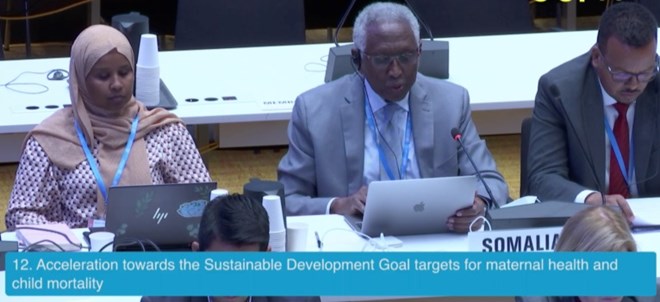
Somalia is leading development of new WHA decision that aims to tackle persistently high rates of maternal, newborn and early childhood mortality.
WHO’s director general says the battle against maternal mortality has stalled; Somalia calls for a new WHA resolution committing to stepped-up action on maternal and child deaths, a leading global health inequality.
The battle against maternal mortality has stagnated and high rates of deaths continue to plague sub-Saharan Africa, as well as other low- and middle-income nations, said World Health Organization (WHO) Director-General Dr. Tedros Adhanom Ghebreyesus on Friday.
“Progress has stalled, and still, a woman dies every two minutes,” he stated.
He was referring to a bleak report from February 2023 showing the world is far off track for achieving Sustainable Development Goal (SDG) target 3.1 for reducing maternal deaths to less than 70 per 100,000 live births.
As of 2020, there was an average of 223 deaths of mothers per live births and in sub-Saharan Africa the death rate was 536 per 100,000 live births, according to the UN inter-agency report.
Friday’s debate at the WHO Executive Board meeting revolved around a draft World Health Assembly (WHA) decision led by Somalia for consideration at the upcoming WHA in May (WHA77). It is aimed at addressing the stark global disparities in maternal, newborn and child health that persist, falling far short of the targets set out in the 2030 Sustainable Development Goal targets on reducing maternal mortality (SDG 3.1) and ending preventable deaths of newborns and children under five years of age ( SDG 3.2).
Opening the discussion, Somalia's representative painted a vivid picture of the leading factors, which are deeply rooted in health inequalities between high- and low-income countries.
"The tragedy of this statistic is that most of these deaths in mothers and their children are preventable or treatable with known effective interventions," he lamented.
“We know that 70% of maternal deaths are due to direct obstetric causes,” he said, reciting a list of factors including hypertension, sepsis, abortion and embolism.
Health system bottlenecks, including cost and capacity constraints, are responsible for an estimated 30% of deaths, he said.
“We are deeply concerned by these preventable tragedies," he added. “The intent of the resolution is to galvanise action on the direct costs of maternal and child mortality, and also to propose interventions to address the root causes.”
Adding to the discussion, Afghanistan's representative highlighted the unprecedented challenges faced by the nation. Political turmoil, economic collapse and restrictive Taliban policies have created barriers to essential healthcare services, particularly affecting women.
"The lives and well-being of millions of Afghan women and children hang in the balance. We cannot remain passive observers in the face of such a humanitarian crisis," urged Afghanistan's representative.
Many countries are off track
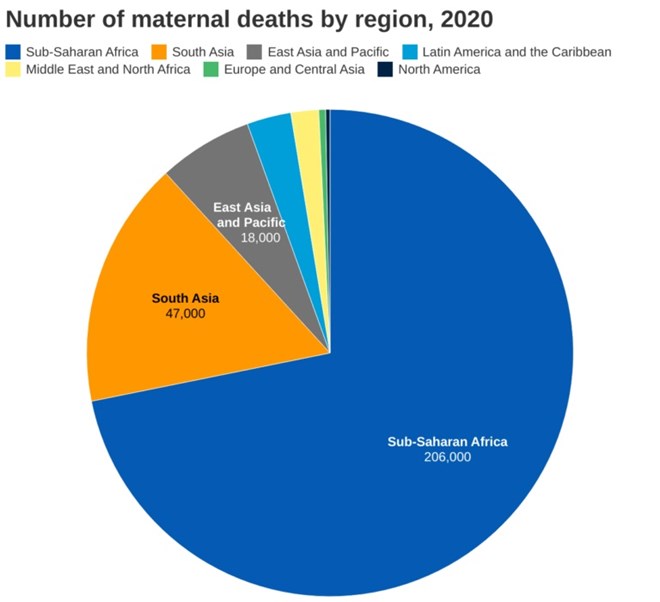
A draft decision was proposed by Egypt, Ethiopia, Paraguay, Somalia, South Africa and United Republic of Tanzania to accelerate progress towards reducing maternal, newborn and child mortality in order to achieve SDG target 3.1 and SDG target 3.2 after data was shared that showed it is likley that more than four out of five countries (80%) will not achieve their national maternal mortality targets, 63 countries will miss their neonatal mortality targets and 54 countries will miss the under-five mortality target by 2030.
The draft decision called for focused, urgent and coordinated course-correcting, and country-led action for maternal, newborn and child survival.
According to the DG’s report, there is ample evidence on effective interventions to monitor and improve the health and well-being of women and children. He noted that multiple strategies have been developed that incorporate this evidence so as to support countries in identifying the high-impact interventions that should be included in their national health sector plans.
These strategies include the Global Strategy for Women’s, Children’s and Adolescents’ Health (2016−2030); Ending Preventable Maternal Mortality; Every Newborn Action Plan; the Roadmap to Combat Postpartum Haemorrhage between 2023 and 2030; the Child Survival Action call; and the Global Accelerated Action for the Health of Adolescents initiative.
He noted that countries that are off track from reaching 2030 maternal and child mortality targets could accelerate progress toward national and global health targets by adopting such strategies and implementing them at scale.
Global Support and Urgency
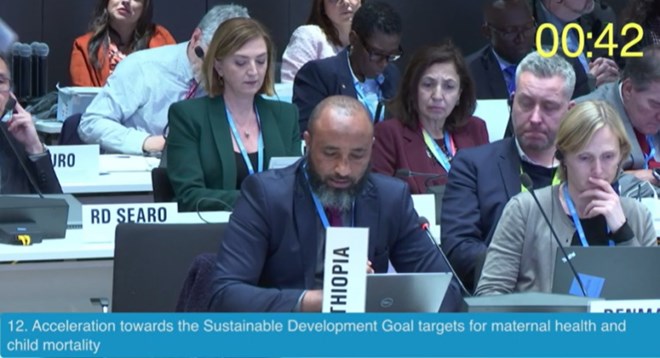
A wide range of countries, from the United States to Ethiopia, speaking on behalf of the WHO African Region, voiced strong support.
The United States voiced its unwavering support for the resolution, emphasising strategic approaches to reduce preventable maternal, newborn and child deaths.
"We recognize that ending preventable maternal newborn and child deaths is critical to achieving universal health coverage and the promise of the SDGs," stated the U.S. representative.
“There is strong consensus among many member states around several strategic approaches to accelerate progress by expanding coverage and equitable access to an integrated package of:
High quality essential health and nutrition services for women and children. These approaches include first, reinvigorating country leadership and commitment to accelerate progress on this crucial unfinished agenda.
Second, adopting a multi pronged approach to maximize investing resources and attract reclaiming and third, aligning and reorienting our investments to strengthen primary healthcare delivery capacity.
Finally, prioritizing the hardest to reach the poorest remotest and historically marginalized communities."
Other member states echoed those messages, calling for intensified technical assistance to catch up after years of progress lost, including during the COVID pandemic.
“We are extremely alarmed about being off track with targets,” said Ethiopia, on behalf of the African Region of the WHO, which includes 47 Sub-Saharan African member states. Countries in the regions are also “still struggling” with the legacy of the COVID-19 pandemic, including a present-day shortage of healthcare workers and a socio-economic crises.
Gender equality and universal access to sexual and reproductive health services
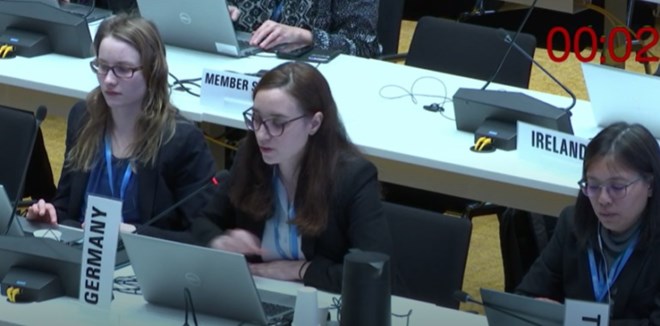
Germany, Norway and others call for universal access to reproductive and sexual health services as key to reductions in maternal mortality.
While the proposed resolution, designed to galvanise global action, could be adopted during the next WHA, some key portions of the draft text, remains in [brackets] - signaling a lack of member state agreement. Notably, these paragraphs revolve around gender equality; empowerment of women and girls; and access to sexual and reproductive health services - reflecting their political sensitivity for many member states.
Even so, Germany, Norway and Australia, as well as a range of non-state actors, underlined the importance of women and girls' education as well as "universal" access to sexual and reproductive health services as critical to reducing maternal mortality.
“Access to sexual and reproductive health and rights including access to free and safe abortion is crucial. Women's rights to bodily autonomy is an essential part of achieving maternal health,” said Norway. “We find it encouraging that levels of adolescent pregnancy and childbearing have declined, but the fact that that 1.5 out of 1,000 young girls give birth before their 15th birthday is still far too many.”
WHO commends decries stark statistics
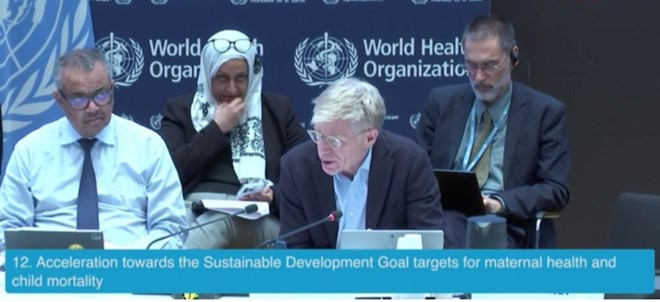
WHO's Bruce Aylward decries the stark disparities between rich and poor countries in maternal, newborn and child mortality at WHO EB 154
Dr Bruce Aylward, Assistant Director-General, Universal Health Coverage, Life Course, commended Somalia for reigniting the conversation about a crucial yet alarming global issue, but he expressed concern for the challenges ahead.
"We keep talking about this as these are preventable deaths, and indeed they are, but sometimes that sounds like well, this is an easy problem to solve," Aylward said. "And again, as we've heard, this is a very difficult problem to solve."
He noted the uphill battle against systemic challenges like workforce shortages, out-of-pocket payments, and inadequate infrastructure.
Tedros - ‘stay hopeful’
"While there are huge barriers, there has been some very rapid progress in countries where the political will was actually there, both to reorient their systems toward a primary health care approach, and to make the reduction of maternal mortality a national priority," Aylward stated.
Tedros stressed the need for tailored measures: "The progress is not there, and the recent report from February 2023 is showing that we are off track, and chances to achieve the SDGs are actually dwindling. But still, I think we need to stay hopeful and we should believe that we can achieve it, especially if we do the right things," he asserted.
He called for political will and commitment from every country: "But as we have said when we presented the DPW 14 maternal and child health, that will be one of the top priorities, and we hope together to make a difference and achieve the SDGs by 2030."
As the session concluded, Dr. Tedros highlighted the board's readiness to proceed with the report and draft decision, signifying the collective acknowledgment of the urgent need to accelerate progress in reducing maternal, newborn and child mortality.